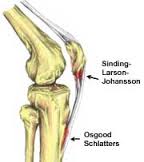Sinding-Larsen-Johansson Disease
Sinding-Larsen-Johansson disease affects the proximal end of the patellar tendon as it inserts into the inferior pole of the patella, and represents a chronic traction injury of the immature junction between these structures. It is closely related to jumpers’ knee or patellar tendinopathy, which is the adult manifestation of this disorder.
What is this?
Sinding-Larsen-Johansson disease affects the proximal end of the patellar tendon as it inserts into the inferior pole of the patella, and represents a chronic traction injury of the immature junction between these structures. It is closely related to jumpers’ knee or patellar tendinopathy, which is the adult manifestation of this disorder.
Demographics and clinical presentation
Unlike jumpers’ knee which is seen at any age, Sinding-Larsen-Johansson disease is seen in active adolescents typically between 10 – 14 years of age. It is usually associated with sports that involve higher volumes of running and jumping. It is also common in young athletes who are overtraining. The patient typically presents with point tenderness at the inferior pole of the patella associated with focal swelling.
Prognosis
This is a self-limiting condition in that it is safe to continue playing sport but the pain will limit the level of function whilst performing the activity. This condition will always resolve long term but can sometimes take until the growth plates start to fuse in the body.
What Structures can be Injured?
- Proximal attachment of Patella Tendon
Pain and Symptoms
Symptoms can include some or all of the following:
- Pain with activity especially running, kicking or jumping
- Pain is at the inferior pole of the patella and is often tender to touch
Diagnosis
Diagnosis is usually made on clinical assessment and there is usually no need for further investigations.
Treatment
Treatment for this condition is always conservative.
Management would usually involve the following:
- Activity Modification – this may range from complete rest to minor modifications in training depending on the severity of the pain and extent of disability
- Strengthening – If there is an obvious lower limb weakness in an area a strengthening program may help increase the control through the lower limb and help unload the patella tendon
- Patella Tendon Taping – Used to help try and distribute the force through the patella tendon and therefore unload the irritated region.
Recovery Time
Highly variable for each individual. In some individuals the symptoms may last up to 24 months before the growth plates fuse. It is important to realise that this is a self limiting condition that will always settle as the tendon/bone interface matures

